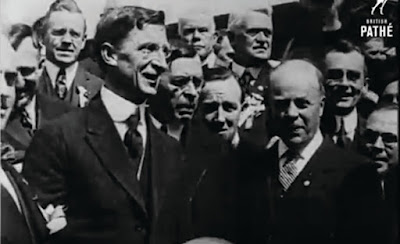In June 1919, Irish Leader Eamonn de Valera Spoke at Fenway Park, Visited Boston's Mission Hill, Bunker Hill, Cambridge & Lexington
Photo from Boston Globe Archives
In June, 1919, Irish political leader Eamon de Valera visited Boston and New England, a trip that included stops at historic American landmarks like Bunker Hill, Cambridge and Lexington, as well as a massive rally at Fenway Park on Sunday, June 29, 1919.
Dev arrived at Boston’s South Station on Saturday, June 28 with his secretary Harry J. Boland, and was greeted by scores of Irish supporters as he made his way to the Copley Plaza Hotel in Boston’s Back Bay. A marching band led the triumphant procession through the streets of Boston.
That evening, Dev visited the rectory at Mission Church in Roxbury,
where his half-brother, Rev. Thomas Wheelwright, C.SS.R. was stationed. After de Valera’s father died in 1885, Dev was
sent back to Ireland where he was raised by his relatives. His mother Catherine Coll of Bruee, Limerick
married Charles Wheelwright, and had two children, Thomas and Ann.
Known formally as the Boston Basilica and Shrine of Our Lady of Perpetual Help, the Mission Church opened in 1870 and is ministered by the Redemptorist Priests, whose mission is to serve the poor and the spiritually abandoned.
As he approached the Mission Church for the 9 a.m.
Sunday mass on June 29, he was greeted by a large crowd of supporters. “When his automobile
approached, a deafening cheer arose, and hundreds tried to push forward and
shake his hand, “ according to news stories. President De Valera knelt
on a prie-dieu at the head of the middle aisle, near the sanctuary rail. The officials who accompanied him included Mayor Edward W. Quinn of Cambridge and President Ford of the Cambridge City Council.
The Rev Father Kenna,
in greeting De Valera, told the congregation,
“A cordial welcome to our honored
guest pours forth from the hearts of our community and all its people on this
memorable occasion. We thank him for
honoring this church by selecting it to assist at the Sacrifice of the Mass. I
assure him that the congregation of no other church in the united states is
more solidly behind him and the cause which he represents than the congregation
of the Mission Church.”
The 125-piece Mission Church Field Band marched from the
church to Fenway Park with 3,000 parishioners.
In total, 6000 people from Irish clubs and societies marched in the Irish association
division.
After breakfast at the Mission Church rectory, Dev returned to the Copley Plaza at 12:30 p.m., where he was presented with
a floral bouquet and a brief address of welcome from the Irish Counties Association.
At 2:30 p.m. the De Valera party, accompanied by the Irish
delegation, headed to Fenway Park by automobile, where 60,000 people eagerly
received him and his message of Irish freedom. He was introduced at Fenway by Massachusetts Governor David I. Walsh, who called de Valera Ireland's Abraham Lincoln. The rally was covered by the international and domestic media.
Courtesy of the Boston Public Library, Leslie Jones Collection
The following day, Monday, June 30, Dev “placed a wreath
beneath the historic elm in Cambridge, under which General George Washington took command
of the American revolutionary army, and another on the Minuteman monument on
the green in Lexington,” wrote the Indianapolis Star.
Dev also visited local landmarks, including Bunker Hill Monument in Charlestown, where he laid a wreath. Then he wrote on a piece of paper the date and the words of George Washington when he heard the Battle of Bunker Hill had taken place, "The liberties of my country are safe." He signed it and placed it on the wreath, wrote The New York Times.
That evening, de Valera addressed the House of Representatives at the Massachusetts State House.
Dev also visited local landmarks, including Bunker Hill Monument in Charlestown, where he laid a wreath. Then he wrote on a piece of paper the date and the words of George Washington when he heard the Battle of Bunker Hill had taken place, "The liberties of my country are safe." He signed it and placed it on the wreath, wrote The New York Times.
de Valera in Boston
That evening, de Valera addressed the House of Representatives at the Massachusetts State House.
He raised the question of
whether the Irish wanted a Republic. “It is said that the Irish are divided
among themselves. This is not so, in
respect to this question. If we could
get a plebiscite, we could carry it four to one. Ulster is mentioned as an exception, but
Ulster is a very small part of the island.
“It is said that this is a religious question,” Dev
continued. “This, too, is not so. It happens that the majority of the Ulster
minority is Protestant and that the majority of the Irish people is Catholic,
but that has nothing to do with the present situation. England has tried to keep alive this claim of
religious difference, but it will not be able to do so and the Irish people
will be united in support of Irish sovereignty.”
Dev's secretary Harry Boland said that De Valera had hoped to meet with Boston’s William Cardinal O’Connell while in Boston, but the meeting did not take place, according to the Catholic Advance of Withica, KS.
In addition to visiting Massachusetts, de Valera also stopped in Rhode Island and New Hampshire, where he was met by enthusiastic crowds. Following that, de Valera traveled across the United States, visiting Irish strongholds like Butte, MT and San Francisco, CA, before returning to New York in the fall.
Read more about de Valera's various trips to New England in Irish Boston: A Lively Look at Boston's Colorful Irish Past.
.jpeg)






Comments
Post a Comment